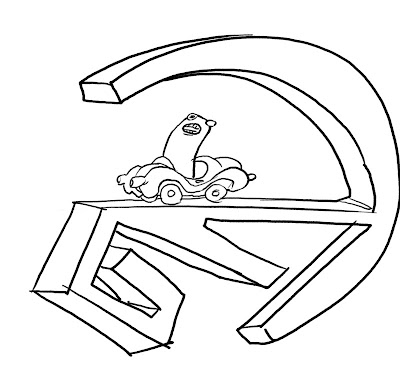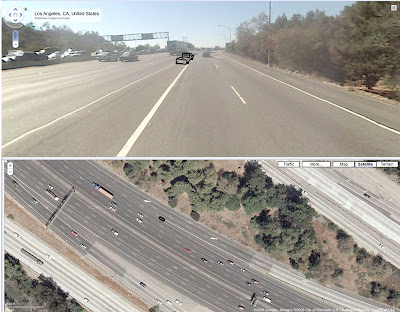
Last week someone gave a friend of mine this drawing. My friend passed it along to me (via email. I don't have the original. Alas!) I was compelled to analyze it:
Thank you for passing along the artwork. My first thought was that this was merely a jolly portrayal of Tony the Tiger, but then I became intrigued by the number 3 on his jersey. At first I was at a loss for what the significance might be. Yet, as I contemplated it, its symbolism began to unfold.
The Holy Trinity comes to mind, but how it relates to the rollerblading tiger is, as yet, unclear. Because the tiger is in such a dynamic pose, the number 3 on his jersey could be an echo of Jung's idea that the number 3 represents dynamic change in the psyche whereas the number 4 signifies wholeness, and therefore a somewhat static situation. The number 3 is also present in the fact that the figure of the tiger is actually breaking the
Morse Code frame on three of four sides. Only the bottom section of the frame remains unbroken, and because the bottom is "the Base" and therefore the "Foundation," I believe that the idea of instability is implied because the figure is not in contact with it. Furthermore, because the figure is moving from right to left I feel that this retrograde motion represents, perhaps, a kind of regression from a former state of wholeness and stability (because, in our culture, we read from left to right).
To take it even further, we see that the paper itself, because of the creases, is broken up into three parts. Interestingly, we see that the lower crease bisects the rear skate in such a way as to elevate 3 of the 4 wheels above the crease. This again symbolizes the regression from a state of wholeness (as represented by the number 4) to a state of flux (as represented by the number 3). I also find it interesting that the only protective gear that our Tiger is wearing falls below the lower crease to what we might assume is a position of lower importance, and that what might be the tiger's most vulnerable piece of anatomy (the head, the brain, the seat of consciousness itself), though elevated above the top crease to a place of relative importance, is conspicuously without protection of any kind. To me, this introduces an element of extreme recklessness to the Tiger's seemingly innocent and lighthearted skate. And, by extension, we might assume that this recklessness is likely present in the behavior (or at very least in the mental makeup) of the artist.
Based on this cursory decoding (it is, after all, drawn in Morse Code-- in itself a cry for understanding, but also a method of maintaining the illusion of strict control and deliberation) of this drawing, we might assume that the artist, though quite animated (cartoon tiger) and playful on the exterior, is beneath it all quite unstable and deteriorating at an accelerating rate.







 If I could have drawn this, then I would have. Cooper has just entered my favorite phase of childhood drawing development. YES!!!
If I could have drawn this, then I would have. Cooper has just entered my favorite phase of childhood drawing development. YES!!!
 I stayed up late last night working on some freelance, and then I got up early (after, of course waking up with the baby throughout the
I stayed up late last night working on some freelance, and then I got up early (after, of course waking up with the baby throughout the  All right, I know the suspense must be killing you. Here's the story I promised on Friday:
All right, I know the suspense must be killing you. Here's the story I promised on Friday:




